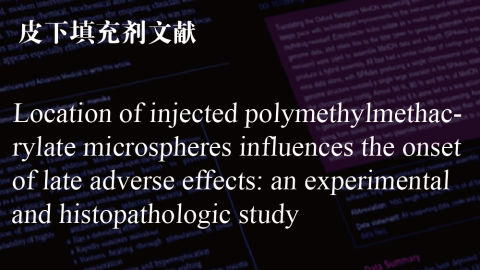
- 3842人
- 分享收藏
Location of injected polymethylmethacrylate microspheres influences
简介
【 文献重点摘要 】
Polymethylmethacrylate (PMMA) has been widely used in the correction of wrinkles because of its long-lasting cosmetic improvements. However, side effects and complications may occur, and its clinical appearance on the oral mucosa can be similar to that of inflammatory or neoplastic disease. The aim of this research was to compare the clinical and histopathologic responses to PMMA injected by two different methods. Twenty-two rats received an injection of PMMA using the tunneling technique (gold standard), with subcutaneous deposition of the filler in the face, or a variation of the technique with transcutaneous submucosal deposition of the filler in the cheek. The tissue reaction was analyzed clinically every 24 hours during the first week, then once a week for the following 3 months. Histologic evaluation was based on the local inflammatory response to the filler. No clinical changes were observed during the initial evaluation period (0–14 days). After 14 days, only the submucosal group showed extra-oral enlargement (n=4, 18.2%). Histopathologic analysis revealed nodule formation in four animals (18.2%) in the submucosal group, with no nodules observed in the subcutaneous group. The data obtained in this study demonstrate that the technique used to deliver the filler may influence the risk of adverse reactions.
Keywords: dermal filler, polymethylmethacrylate, adverse reactions
聚甲基丙烯酸甲酯(PMMA)因其持久的美容效果而被广泛应用于皱纹矫正。然而,可能会出现副作用和并发症,其口腔粘膜的临床表现可能类似于炎症性或肿瘤性疾病。本研究的目的是比较两种不同注射方法对PMMA的临床和组织病理学反应。22只大鼠接受了使用隧道技术(金标准)的PMMA注射,填充物在面部皮下沉积,或者在脸颊经皮下粘膜下沉积填充物的技术变体。在第一周内每24小时临床分析一次组织反应,然后在接下来的3个月中每周分析一次。组织学评估基于对填充物的局部炎症反应。在最初的评估期(0-14天)没有观察到临床变化。14d后,仅粘膜下组出现口外扩张(n=4,18.2%)。组织病理学分析显示粘膜下组有4只动物(18.2%)形成结节,皮下组未观察到结节。在这项研究中获得的数据表明,用于输送填充物的技术可能会影响不良反应的风险。
关键词:真皮填充剂、聚甲基丙烯酸甲酯、不良反应



